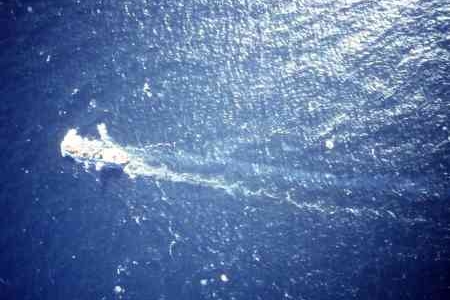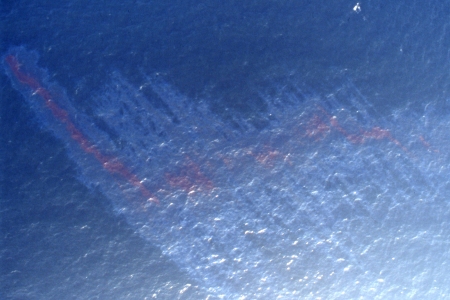Airborne Oil Pollution Patrol 1:
Visual Appearance of Oil on the Water Surface
Scenario
Maritime surveillance aircraft are operated by many agencies responsible for monitoring of coastal waters in Europe. Oil spills detected during flight missions are reported to authorities for prosecution of polluters.
We are operators of oil spill detection instruments, underway aboard a surveillance aircraft ...
|
A maritime surveillance aircraft. Source: Federal Ministry of Transport, Germany. |
... and we happen to detect two oil spills on the sea surface!
During overflight we take pictures with a downward looking photocamera installed aboard the aircraft. There is oil on the water surface which is a hazard for the environment!


Oil does not dissolve in water and its density is lower than the density of water. Therefore, oils discharged at sea float on the water surface. Depending on the discharged quantity, oil spills can have a very different appearance when seen on board an aircraft during overflight. In the left image, a ship is identified while it was spilling oil. In the right image, the ship has disappeared and left a spill behind which spreads over the water surface due to wind and waves.
Questions
- Why do thin oil films appear as a bright silvery shine, while thick layers appear brown or black?
- Can this colour be used to estimate the layer thickness?
- What would be the advantages and limitations of such a procedure?
- Can you recommend visual or photographic inspection of oil spills
a) to measure thin oil films caused by controlled (and mostly illegal) discharges of small oil quantities?
b) to detect thick layers of oil caused by accidental discharges for an efficient guidance of oil spill response vessels during clean-up operations?
Procedure
- First lesson in class: Get together in groups of no more than five students and
- discuss the questions about the physical characteristics of oils and their behaviour on the water surface,
- decide which background information you may need to solve the problem, and
- assign a task to each member of your group which should be resolved by the time of the next lesson in school.
This should enable you to solve the given problem and present the results to your class.
Please note: not all the backgound information offered to you is needed to solve the problem! It's up to you to decide which information you may need.
- Homework: Resolve the task that has been assigned to you by your group.
- Second lesson in class:
- present what you have learned to your group
- discuss how your findings can help you to answer question 4, i.e. the choice of best instruments and methods for a given scenario
- present your results to your class using the information found in your enquiries.
Materials
- Version of this worksheet: Visual appearance of oil on the water surface, as printable rtf file
- Oil pollution and the fate of oil at sea
- Airborne maritime oil spill surveillance
- Visual appearance of oil on the water surface
- Oil spill maps based on aerial detection

